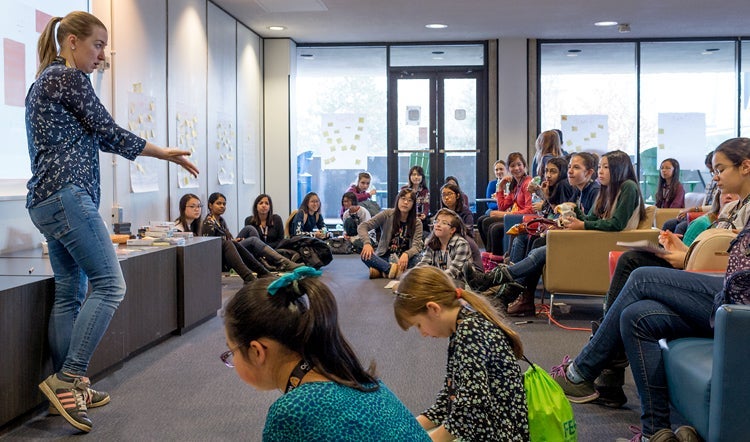Women were there in the beginning.
Women were the first computers — the people who performed complex mathematical calculations with pencil and chalk — and later, as the field of computer science emerged, they were the first programmers.
But computing isn’t dominated by women today. They are underrepresented in computer science and in the tech industry. Although some gains have been made — the proportion of female undergraduate students enrolled in Faculty of Mathematics computer science programs has increased in recent years — today only about one in five computer science undergraduates at Waterloo are women, a statistic all too common at many universities.
“The gender gap in computer science has many causes — some historical, others more recent,” said Professor Jo Atlee, the Director of Women in Computer Science at Waterloo. She explains that the main reason the gender gap persists today often boils down to the exposure to and experiences with computing that girls get from their earliest days.
“The gap starts well before students begin university,” said Atlee. “It would be wonderful if we had K-12 education in computing, just like we do for English and math, but computer science often isn’t offered let alone mandatory.”
“Some kids attend computing camps in grade school, are encouraged by their parents to take computer courses, to play with computers,” Atlee continued. “However, other students don’t get these opportunities, so even if they’re exposed to computer science at university, which all of our math undergrads are, they come in with an experience gap. This is particularly true of female students. This isn’t a show-stopper — inexperienced students do catch up. But the experience gap engenders a self-confidence gap, and this gap scares many students away from studying computer science.”
One powerful solution is exposing girls to programming early on. Susan Wojcicki, the CEO of YouTube, has an interesting story about this, Atlee recounts, adding that the kind of exposure is key. “Susan had one computer in the home that her son dominated. At the time, her 10-year-old daughter said she hated computers, so she enrolled her in a computer camp to see if it would spark an interest. The camp was filled mostly with boys, so she came back even more discouraged. She then sent her daughter to an all-girls computer camp and she came back captivated.”

Technovation Waterloo
This is precisely the supportive environment Atlee hopes to replicate here through Technovation Waterloo — giving girls from Grades 5 to 12 an opportunity to not only see what computing is like but also letting them dive more deeply into computing by building a mobile app of their own design.
Technovation does this in an environment that is purposely female-dominated — from student participants to mentors to instructors. Girls meet other girls who are interested in technology and entrepreneurship and, equally important, they are mentored and instructed by female undergraduate and graduate students from Waterloo along with women from the local tech industry, all of whom serve as powerful role models.
It’s the sort of opportunity that likely would have given Anna Lorimer, a joint Honours Computer Science and Combinatorics & Optimization undergrad at Waterloo, an added edge. “My high school didn’t have computer science courses at all but I was very much a math whiz, so I applied to undergrad math programs,” she said. “I didn’t take computer science until I started university — a theme common among girls. Lots of boys are exposed to computers at a much younger age than girls are. And a lot of young women applying to university simply don’t know that computer science is an option. This limits the number of women entering the field.”

The repercussions of a male-dominated discipline extend beyond lost career opportunities for women, Lorimer explains. “It’s also about being intimidated or discouraged at many steps along the way, whether it’s blatant examples like being told by men that you don’t belong in computer science to more subtle forms of intimidation and discrimination such as being given less challenging tasks or being paid less than male colleagues.”
The repercussions also limit ideas and industry insight. “At a basic level, the more diverse the people you employ, the better the ideas, the better the field, the better the product,” Lorimer said, adding that with greater diversity more bases are covered and more attention paid to details.
“A good example is Apple’s HealthKit app, which didn’t originally include a period tracker, Lorimer recounts. “It’s safe to assume that about 50 percent of the people who buy Apple mobile devices are women, but this basic feature wasn’t included in the health app.”
Despite examples such as this, computer science continues to be a dominated by men, which restricts entry to the field by women. That’s a big challenge to overcome and it will take much effort, but we can make room for girls now. By building their confidence and giving them opportunities such as the Technovation challenge, girls can be set up to succeed.